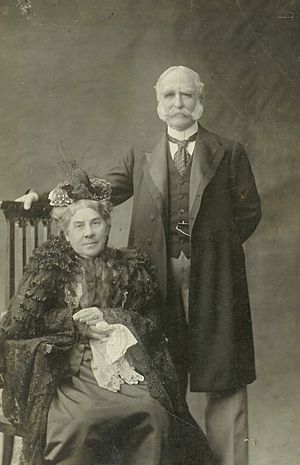Harriet Tracy facts for kids
Harriet Ruth Brisbane Tracy (born December 6, 1834 – died May 30, 1918) was an amazing American inventor. She received patents for at least 27 inventions! These included six for elevators and seventeen for sewing machines. Many of her inventions were created between 1890 and 1893. Harriet Tracy even showed off some of her inventions at a big event called the World's Columbian Exposition in 1893. She was also a talented writer, sharing her stories and poems in magazines.
Contents
Early Life
Harriet Ruth Brisbane was born in Charleston, South Carolina. Her parents were William Brisbane and Julia Hall Lowndes.
Harriet Tracy's Inventions
Harriet Tracy's first invention was a special crib attachment for beds in 1868. Besides her many sewing machine and elevator patents, she also invented a cooking stove. She also created a clever fire escape. She described it as a "simple, cheap, durable, compact, and efficient fire-escape ladder." This ladder could be folded up very small.
The Tracy Gravity Safety Elevator
Tracy's most famous invention was an elevator patent she received in 1892. It was called the "Tracy Gravity Safety Elevator." This elevator had a special safety system. It would slow down if the power went out.
This elevator was used in the Woman's Building at the World's Columbian Exposition in Chicago. Visitors used it to go up to the dining areas on the roof. Her gravity elevator was also used in New York City.
Sewing Machine Innovations
At the exposition, Tracy also showed off several of her sewing machine inventions. These were displayed in the Liberal Arts Building. Her most popular one was the "Tracy Lock-Stitch and Chain-Stitch Sewing Machine." This machine had a new rotary shuttle part. It could hold a lot of thread, up to 1,000 yards!
Personal Life
In 1860, Harriet married Cadwallader Colden Tracy. He was a baseball player for the New York Knickerbockers. For about 30 years, from 1860 to 1890, she lived on Staten Island, New York. Harriet and her husband had four daughters. Later, they moved to Paris, France, around 1890. After that, they moved to London, England.
Legacy and Impact
Harriet Tracy passed away in 1918 in Brentford. She was very well known for her inventions in the late 1800s. She was one of the first important American women innovators. Back then, only about 1% of all inventors who received patents in the United States were women. Not much is known about most of these women, but Harriet Tracy is different.
Tracy became famous for her inventions. Many of her creations were praised in Chicago newspapers. Her inventions were also shown at big events, like her lock-stitch and chain-stitch sewing machine at the Chicago Columbian Exposition. Even though she was famous in her time, she has mostly been forgotten today. There are not many books or materials about her achievements. Still, Harriet Tracy's work created a legacy that lasts far beyond her lifetime.
Harriet Tracy is an inspiring person for girls and women interested in STEM careers. STEM stands for Science, Technology, Engineering, and Math. She showed what it means to "break the glass ceiling." This means succeeding in a field that is usually dominated by men. She worked very hard and made a name for herself in the world of invention.
Collections
Patent Model - Improved Crib-Attachment for Bedsteads, February 25, 1868, Hagley Museum and Library



